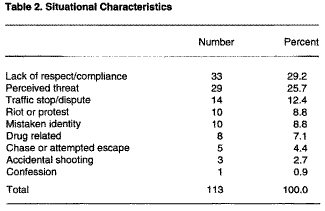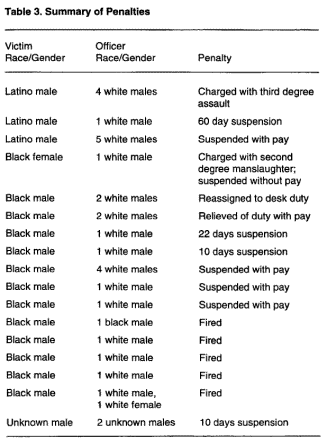The circumstances leading up to the final violent assault between the police officer(s) and the civilian victims could be analyzed in 113 of the altercations. For these 113 cases, the preceding events can be grouped into nine main categories, listed here in order of greatest occurrence: lack of respect or compliance on the part of the victim; perceived threat; traffic dispute or stop (included malfunctioning equipment or allegations of erratic driving); mistaken identity (the civilian appeared to match a description of an armed and dangerous individual); riot or protest-related incident (citizen was perceived or actually involved in a riot or protest); drug-related arrest (six of the eight reported incidents involved the forcible entry into homes of civilians in a search for drugs that did not exist); police chase or attempted escape; accidental shooting; and questioning or confession. The basis for classification was the circumstance that seemed to contribute the most to the assault. For example, if a motorist was stopped by police officers and proceeded to act in a threatening manner towards the officers, the incident was classified as a perceived threat, not a traffic stop. Only a few of the cases required this type of judgement call. The number of cases falling within each of these categories are displayed in Table 2.

Table 2. Situational Characteristics
The largest proportion (29.2 percent) of the cases involving a violent police-citizen encounter stemmed from a lack of respect or compliance on the part of the citizen toward the police officer. This finding is consistent with previous findings (see, for example, Croft, 1985; Westley, 1970). The actual circumstances surrounding the inadequate display of deference toward the officer were varied: The victim may have refused to provide his or her identification to the questioning officer, the victim may not have followed orders from the officers as quickly or as well as the officers may have liked, the victim may have had a "bad attitude" or failed to give the officer the amount of deference they expected, or, in a few cases, the victim may not have been able to communicate with the officers due to a handicap or lack of fluency in the English language.
Twenty-nine cases (25.7 percent) were the result of a perceived threat -- either the officer felt that his (rarely her) own life or the life of another citizen was in jeopardy. Complaints of brutality that resulted from the circumstances included within this category may be rationalized by many individuals. The police officer(s) involved felt that he or she was in a life or death situation: a gun may have been pointed at the officer or another citizen, or there may have been an escalating physical struggle. According to the findings of this study, more of the victims of police brutality had been disrespectful to officers than had posed a serious physical threat to the officers or other citizens.
In police/minority situations the use of racial slurs can be important. The use of racial slurs or epithets by officers in reference to citizens was noted by the media source in 25 of the 130 cases, with most of the targets of this form of abuse being African Americans. Only two slurs against Latino citizens were reported. Racial slurs and epithets, derogatory statements directed toward a minority group member, have been reported to be common in a number of police departments. For example, the Christopher Commission, in its review of the Los Angeles Police Department, found numerous racist comments in computer transmissions between the cars of the patrol officers, including some from sergeants who were on street patrol. Further, citizens are not the only recipients of racist treatment by the police officers. Janine Bouey, a light skinned black female officer with the Los Angeles Police Department complained to the department about the use of racial slurs that were made against suspects while in her presence (Serrano and Soble, 1991). Gregory Thomas, also of the Los Angeles Police Department, complained to a supervisor on several occasions that a fellow officer continually referred to him as "boy" and made racist jokes on Martin Luther King Day (Hudson, 1991).

